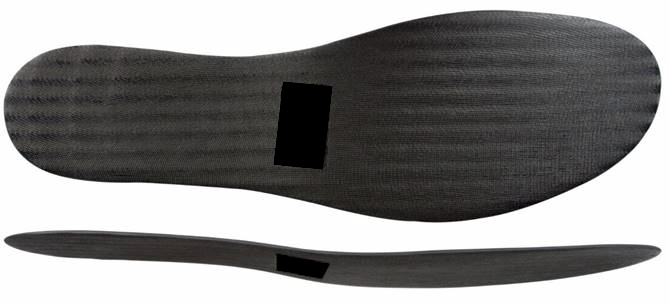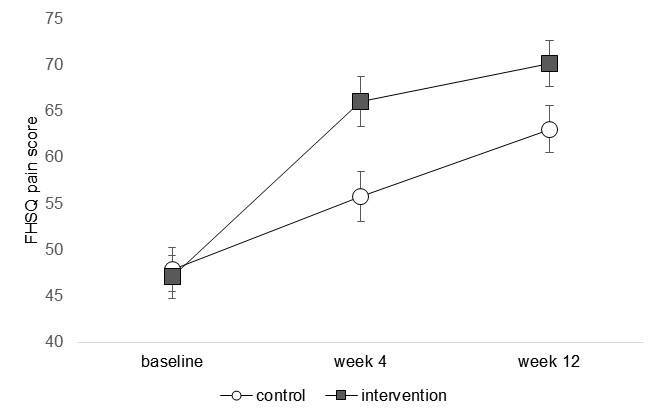Session Information
Date: Sunday, October 21, 2018
Title: Orthopedics, Low Back Pain and Rehabilitation Poster – ACR/ARHP
Session Type: ACR/ARHP Combined Abstract Session
Session Time: 9:00AM-11:00AM
Background/Purpose: This trial assessed the efficacy of shoe-stiffening inserts for reducing pain associated with first metatarsophalangeal joint (MTPJ) osteoarthritis (OA).
Methods: One hundred participants (45 men 55 women, mean age 57.5, SD 10.3 years) with first MTPJ OA received rehabilitation therapy and were randomised to receive either (i) full-length carbon fibre shoe-stiffening inserts (Figure 1) (intervention group) or (ii) sham shoe inserts (control group). The primary outcome measure was the foot pain domain of the Foot Health Status Questionnaire (FHSQ) assessed at 12 weeks. Secondary outcome measures included the function domain of the FHSQ, severity of first MTPJ pain, general health status, use of rescue medication and co-interventions, adverse events, physical activity levels and global change in symptoms (‘moderately better’ or above considered a successful outcome). FHSQ and global change in symptoms at 12 weeks are presented here. Multiple imputation was used to replace missing data. FHSQ pain scores were analysed using analysis of covariance with the intervention group and baseline scores entered as independent variables, and global change in symptoms was analysed using absolute and relative benefit, and number needed to treat.
Results: Data were available for 91 participants at week 4 and 85 participants at week 12. FHSQ pain scores improved in both groups. There was a statistically significant difference in FHSQ pain in favour of the intervention group at 12 weeks (adjusted mean difference 7.4 points, 95% confidence interval [95% CI] 1.3 – 13.5, p=0.018). See Figure 2. Participants in the intervention group were also more likely to report that their pain was at least moderately better (successful treatment) at 12 weeks compared to the control group (61 versus 34%; absolute benefit increase 27% [95% CI 6 – 45], relative benefit increase 79% [95% CI 11 – 189]). The number needed to treat was 4 (95% CI 2 – 18).
Conclusion: Carbon fibre shoe stiffening inserts are effective at reducing pain in people with first MTPJ OA.
Figure 1. Full-length carbon fibre shoe-stiffening insert.
Figure 2. Foot Health Status Questionnaire (FHSQ) scores at baseline, week 4 and week 12 for the control and intervention groups. Higher scores indicate less foot pain.
To cite this abstract in AMA style:
Munteanu S, Landorf K, McClelland J, Roddy E, Cicuttini F, Shiell A, Auhl M, Allan J, Buldt A, Menz HB. Efficacy of Shoe-Stiffening Inserts for First Metatarsophalangeal Joint Osteoarthritis: Preliminary Findings from the Simple Randomised Controlled Trial [abstract]. Arthritis Rheumatol. 2018; 70 (suppl 9). https://acrabstracts.org/abstract/efficacy-of-shoe-stiffening-inserts-for-first-metatarsophalangeal-joint-osteoarthritis-preliminary-findings-from-the-simple-randomised-controlled-trial/. Accessed .« Back to 2018 ACR/ARHP Annual Meeting
ACR Meeting Abstracts - https://acrabstracts.org/abstract/efficacy-of-shoe-stiffening-inserts-for-first-metatarsophalangeal-joint-osteoarthritis-preliminary-findings-from-the-simple-randomised-controlled-trial/


